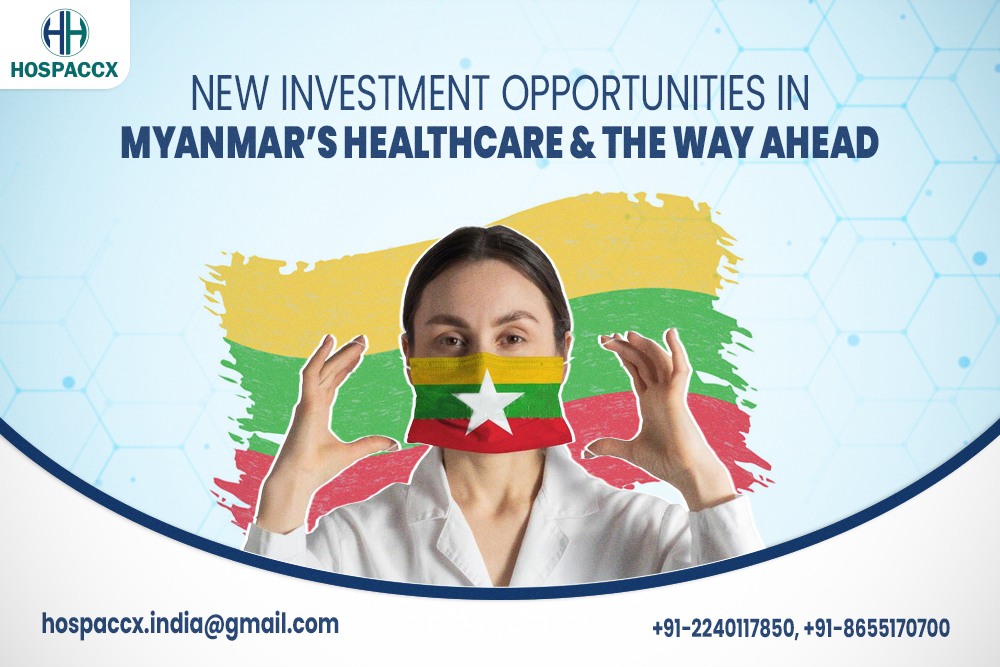Myanmar, while it was emerging as a land with multiple opportunities for investments into the healthcare sector, the country is now facing the uncertainty of future scope for new investments, since the oppressive rule of the Tatmadaw Military group came into Myanmar’s political power.
Wouldn’t you want to know about the current investment market in Myanmar? Are you curious to know about the probability of growth for investments in healthcare?
Through this article, Hospacxx Healthcare Consultancy brings to you key information on the current investments market in Myanmar, along with pointers on the probability of future opportunities in Healthcare Investments.
GROWTH IN INVESTMENT MARKET IN MYANMAR
Since 2011, the economy had grown by an average of about seven percent a year, helping it to reduce its poverty rate, which fell from 48 percent of the population in 2005 to 25 percent in 2017, according to World Bank data. Foreign direct investment shot up from $1.4bn in 2012-2013 to a peak of almost $9.5bn in 2015-2016, according to the government’s Directorate of Investment and Company Administration. In the previous year, Myanmar received investments of $5.5bn.
According to a report by Oxford Business School, till 2014, foreigners were barred from investing in Myanmar’s health care sector. But presently, they are allowed to invest in private hospitals, clinics, diagnostic services and devices, as well as health-related education, provided they do not own more than 80% of the venture. That compares positively with the region, where the investment limits range from 100% in Singapore to 30% in Malaysia.
Singapore was the largest single foreign investor in the 2019-2020 fiscal year, Myanmar’s official figures show, but not in comparison to the combined investments from China and Hong Kong, where they emerge on the top. Other countries like India, Thailand, Vietnam, USA had maintained close ties with Myanmar through FDI’s. As foreign investment peaked in 2016, so did overall economic growth.
RISE OF UNCERTAINITY IN THE FUTURE OF INVESTMENTS
Myanmar’s economy and its attractiveness as a destination for foreign investment had begun to fade even before the military overthrew Aung San Suu Kyi and her party from power this month.
The Foreign investment value has gone down significantly post-coup. Since 2011, approximately 90 percent of FDIs in Myanmar is derived from Asian countries, who have been steadily enhancing economic ties. However, in response to the coup and under pressure from activist groups and western nations, several firms are restricting their ties with the Myanmar Economic Holdings Limited (MEHL) and Myanmar Economic Corporation (MEC).
Singapore, which has the highest investment in Myanmar since 2011, has currently removed military affiliated firms from its portfolio. Similarly, Japan has cut its aid post the coup. In addition, some 11 percent of the more than 180 Japanese firms stated that they had terminated their operations in Myanmar due to difficulties in operating business activities. While Indian companies, both state-owned and private, are on a wait-and-watch mode.
The Violence in and around workplaces, internet shutdowns, and scarcity of employees have led office spaces to shut down.
In spite of all this, China continues to advance plans for a complex economic corridor under its Belt and Road initiative (BRI), even though deep-seated resentment towards China is increasing across Myanmar. Despite Myanmar’s political turmoil, BRI projects are proceeding with the military junta’s assurance. The military junta has reorganized the working committees of several developmental projects that are crucial under the China-Myanmar Economic Corridor (CMEC). It is speeding up and planning several projects to enhance cooperation between Beijing and Naypyitaw.
During and post-COVID-19 pandemic, international investment policies as reflected in the domestic policies and international investment agreements (IIAs) required a bigger role of States in the investment scene, especially in facilitating both domestic and foreign investment through a more structured and effective investment facilitation.
CURRENT INVESTMENTS MADE IN MYANMAR
- ASEAN has made health care a priority of its economic integration plans, with a focus on trade in pharmaceuticals and medical equipment, as well as the provision of health services and the extension of mutual recognition agreements allowing medical professionals to work throughout the ASEAN region.
- One of the more ambitious projects is PHSH, a joint venture (JV) between Serge Pun & Associates (SPA Group) and Indonesia’s Lippo Group, the conglomerate that operates the Siloam Hospitals Group in the archipelago. The JV plans to build on the reputation of PHSH, which was opened by SPA in 2005, before Lippo took a 40% stake in 2014, to open more than 10 hospitals across Myanmar by 2023, with the first to open in Mandalay in 2017. SPA Group wants its facilities to be internationally competitive, but also accessible so offers tiered pricing.
- The Union Government had created the long-term National Comprehensive Development Plan (NCDP), consisting a set of four five-year plans covering the period 2011 to 2031, as part of the second stage of the reform process to enhance economic development and to raise the living standards of the people. MOH is involved in this process by contributing the health-sector component of NCDP. (MOH, 2013). The government also recognizes the importance of updating its overall health policy and strategies, including major review of how best to upgrade medical education, how to retain highly trained personnel in public service, how to develop an effective health information system, and how best to finance health care.
- The World Bank, the Global Fund and the Three Millennium Development Goals Fund were working together towards universal health coverage, to provide financial assistance to tackle HIV/AIDS, tuberculosis (TB) and malaria, as well as support for the development of health care for pregnant women and children.
- The UK government, under the Department for International Development, had been working with the MoH to modernize the Yangon General Hospital (YGH). The 2000-bed facility is the main training hospital for the country’s medical university, and its 1800 staff, including 300 doctors and 480 nurses, widely seen as the most skilled in the country. The hospital handles more than 3000 patients every day, some 300 of them emergency cases. The work at YGH includes not only building improvements – new roofing, ventilation systems and drainage – but also a reform of the means for storing medical records. Additionally, a visiting professorship programme involving oncology and nuclear medicine training was planned for 2016. The renovation at YGH has also brought more up-to-date medical equipment, including a MMK210m ($170,580) endowment of modern equipment from Sea Lion, the local agent for GE Healthcare. GE has sold 13 of its digital imaging CT scanners to hospitals in Myanmar.
- Malaysia’s IHH Healthcare, the world’s second-biggest hospital operator with the Gleneagles and Parkway brands, signed an agreement in January for a $70m, 250-bed hospital on a prime tract of government land close to YGH, which it expected to open in 2020.
While opening up the market for investments could help raise standards and improve medical knowledge, this process needs to be effectively managed, as the increase in foreign investment can worsen inequalities in the current Myanmar health care system. In Myanmar these foreign investments are often utilized for medical establishments in the urban area, thereby focusing on good-income patients.
These investments can also lead to the internal brain drain of medical professionals, as more experienced and skilled medical professionals work in the foreign hospitals that offer good salaries. Many medical professionals work in both the public and private sectors, with private employment supplementing the public sector salary. Therefore, investors must ensure that through these investments, a strong health system is made for promoting the equitable and affordable access to health care for all Myanmar citizens; according to Dr Kyaw Min Soe, a researcher at the Research Centre for Health Economics and Evaluation.
CONCLUSION
Though there is an uncertainty for growth in future investments, in view of the ongoing oppressive rule of the Military Junta in Myanmar, countries around the world still need to facilitate new investments especially in the medical related products and services; and to facilitate the implementation of approved investments. This is to ensure business continuity, for the safe and efficient cross-border movement of goods including medical products and food items. The Healthcare sector still proves to be presenting various opportunities that would help to improve the standard and affordable access to all healthcare services. Yet investments can only be planned with caution, with the hope for greater extent in expansion and advancement of the healthcare sector.
Hospacxx Healthcare Consultancy, likewise, has worked across Indian and International States on Hospital Projects for Business Process Development, Service Quality Assurance, Financial Management and more. For more information, you can visit the company website on www.hospaccxconsulting.com or contact us directly
Related Team Members










